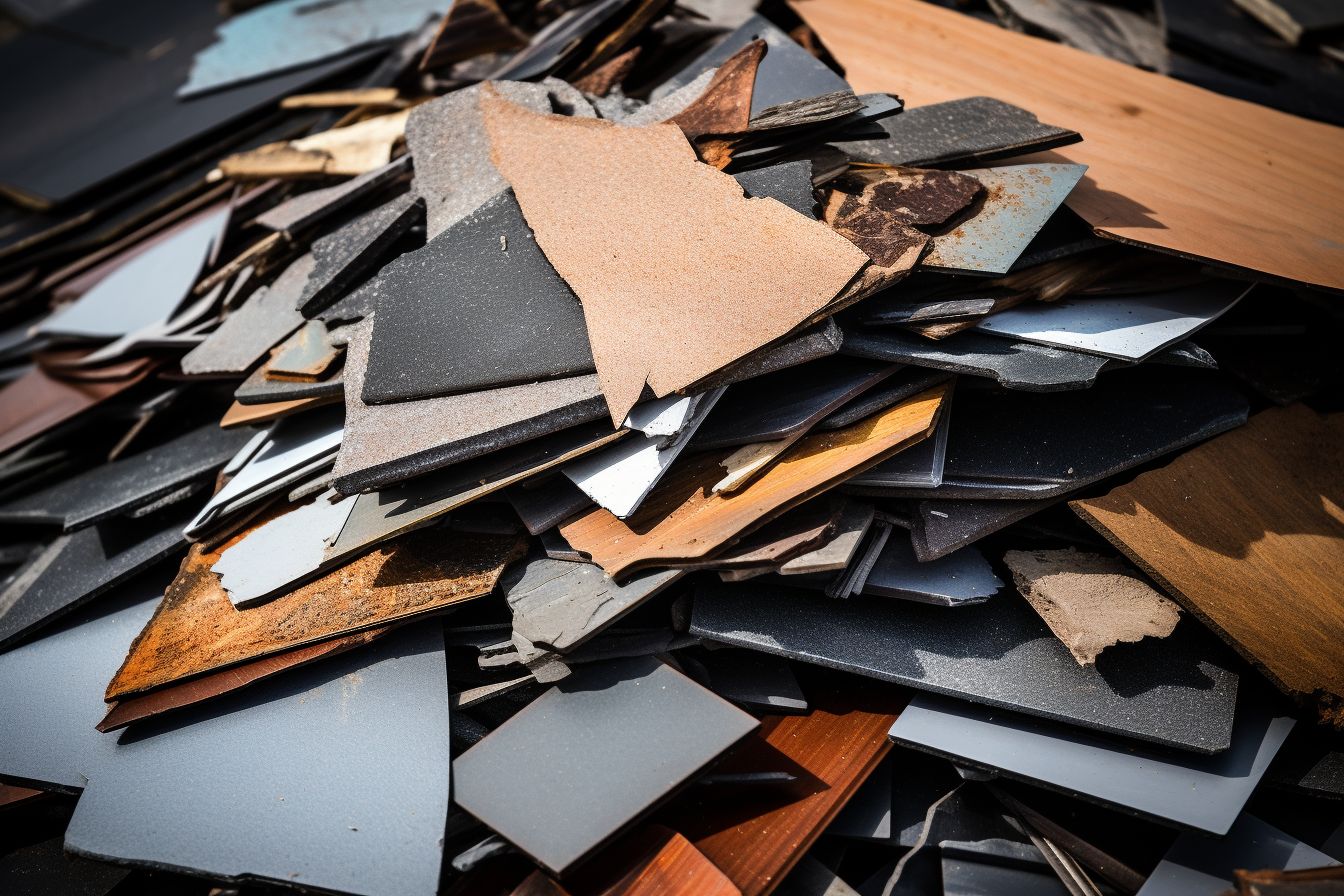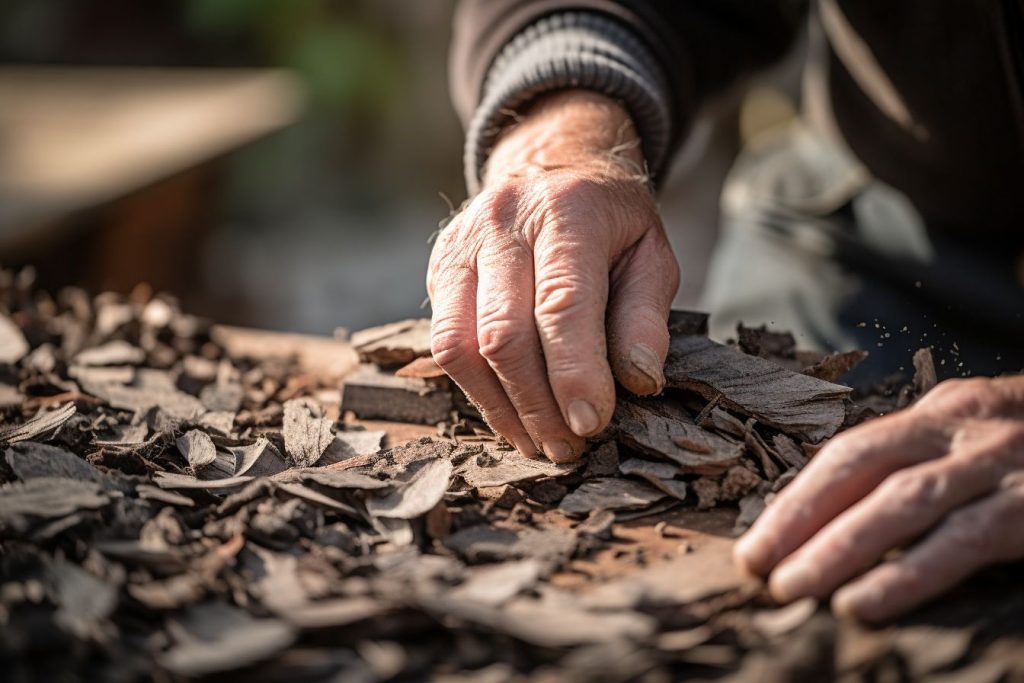Do you have leftover roofing materials cluttering your garage or shed? You’re not alone; many homeowners face the same issue after a roofing project. This blog will unravel creative and practical ways to repurpose these leftovers, transforming them from waste into value assets.
Get ready to be amazed by the potential of your excess shingles!
Key Takeaways
- Save leftover roofing materials for future repairs to save money and promote sustainability.
- Repurpose the materials for smaller home projects like building structures or creating pathways.
- Consider donating or recycling the excess roofing materials to reduce waste and positively impact the community and the environment.
Ideas for Reusing Leftover Roofing Shingles
Save them for future repairs, use them for smaller projects, create an accent wall, build a pathway or traction surface, and donate or recycle them.
Save them for future repairs.
Keeping leftover roofing materials for future repairs can be an innovative and cost-effective move. Asphalt shingles, often remaining after a major roof installation, make excellent patches for minor damages that may occur over time.
Roofers sometimes save these remnants for small projects or necessary tweaks in their work. With proper handling and assessment of the condition, reusing these building materials provides financial benefits and promotes sustainability in home maintenance practices.
Use them for smaller projects.
Leftover roofing shingles offer a cost-effective and resourceful solution for smaller home projects. Their sturdy materials are excellent for building structures like gazebos, doghouses, or sheds.
These projects can add a unique charm to your homestead and give new life to those extra shingles gathering dust in the garage.
Crafting minor DIY improvements around the house utilising repurposed roofing materials saves money and reduces waste. Imagine turning those untouched tiles into a charming pathway or traction surface in slippery spots! Your creative endeavours in reusing roof leftovers will be highly beneficial and noteworthy.
Create an accent wall.
Creating an accent wall with leftover roofing shingles adds a unique flair to your home decor. Use cedar, slate or wooden shingles for this DIY project. You can transform any ordinary wall into an eye-catching feature with just a nailer or hammer, utility knife, tape measure, and a bit of paint.
A quick coat of white paint or stain enhances the look and gives it that extra edge in appeal. This repurposing idea makes what was once wasted roofing material a creative artwork in your living space!
Build a pathway or traction surface.
Leftover roofing shingles can be repurposed to build a pathway or provide traction on surfaces such as stairs. These shingles’ rough texture creates a non-slip surface that reduces the risk of slips and falls.
Using them for walkways or areas that require added grip can eliminate the need for additional de-icing materials in colder climates. These repurposed shingles add a unique texture to your outdoor spaces and ensure safer and more secure surfaces for your family and guests.
Donate or recycle them.
One option for dealing with leftover roofing materials is to donate or recycle them. Some organisations, like IBEX Roof, accept donations of unused shingles and other roofing materials and give them to charities such as Habitat for Humanity.
Donating these materials can help those in need while reducing waste and promoting sustainability. In addition, many recycling centers accept shingles for recycling purposes. Shingles can be recycled into paving materials, roadways, new shingles, and fuel.
Recycling your old roof not only helps the environment but also contributes to creating new products from recycled materials. By donating or recycling your leftover roofing materials, you can positively impact the community and the planet.
How to Recycle Your Old Roof

Recycling your old roof is a responsible and eco-friendly way to dispose of the materials. Here are some steps you can take to recycle your old roof:
- Separate the different materials: Before recycling, separating the different roofing materials is essential. This includes separating metal flashings, wood scraps, and asphalt shingles.
- Research local recycling centers: Look for recycling centers or facilities in your area that accept roofing materials. These centres specialise in processing and recycling different types of roofing materials.
- Contact a reliable recycler: Contact a reputable recycler specialising in recycling roofing materials like metal, wood, or asphalt shingles. Ensure that they follow environmentally friendly practices in their recycling processes.
- Follow proper disposal methods: When transporting the roofing materials to the recycling facility, ensure proper disposal methods, such as securing them safely in a vehicle or container.
- Consider alternative uses: If you cannot find a local recycler for certain materials, consider repurposing them for other projects around your home or donating them to organisations that can use them.
Benefits of Reusing Leftover Roofing Materials
Reusing leftover roofing materials offers cost-saving opportunities for future repairs, allows for unique and creative home projects, and provides an environmentally friendly option for disposal.
Cost-saving for future repairs
Reusing leftover roofing materials for future repairs can help save you money in the long run. By saving those extra shingles, you won’t have to spend more on purchasing new materials when repairs are needed.
This cost-saving option allows you to efficiently maintain your roof without breaking the bank. Reusing these materials is environmentally friendly and promotes sustainability by reducing waste and conserving resources.
So, next time you have leftovers from a roofing project, consider holding onto them for potential future repairs – it’s a smart and economical decision!
Unique and creative home projects
Reusing leftover roofing materials opens up possibilities for unique and creative home projects. Instead of letting those extra shingles go to waste, consider repurposing them into stunning accents for your living space.
From creating a one-of-a-kind accent wall to designing eye-catching furniture pieces, the only limit is your imagination. By incorporating these leftover materials into your home, you add a touch of originality, contribute to the conservation of resources, and reduce waste.
Get inspired by successful DIY projects using old shingles, slate, or clay tiles and unleash your creativity today!
Environmentally friendly option
Reusing and recycling leftover roofing materials is an environmentally friendly option that promotes sustainability in the construction industry. By repurposing these materials, we can reduce waste and conserve natural resources.
Recycled asphalt shingles, for example, can be reused as paving or patching material for roads and bridges. Roofing shingles made from recycled plastic and rubber are also available, offering a greener alternative to traditional options.
Embracing this eco-friendly approach helps protect the environment and contributes to the circular economy by reducing the need for new production and minimising landfill waste.
Considerations for Reusing Leftover Roofing Materials
Proper storage, local regulations, and safety precautions are essential when reusing leftover roofing materials. Find out more on how to make the most of your excess supplies.
Ensure proper storage to maintain quality.
To maintain the quality of leftover roofing materials, it is crucial to store them properly. Roofing suppliers advise storing asphalt shingles in a dry and well-ventilated area, away from moisture and extreme temperatures.
It’s best to find a safe spot to protect the shingles from damage. Following these storage guidelines ensures that your leftover roofing supplies stay in good condition for future use and remain effective when needed.
Check with local regulations for disposal options.
To ensure proper waste management and environmental sustainability, it is crucial to check with local regulations for disposal options when dealing with leftover roofing materials.
Local authorities have specific guidelines to determine the appropriate methods for disposing of construction and demolition waste, including roofing materials. By adhering to these regulations, you can avoid contributing to landfill space, pollution, and wasted resources.
Take responsibility by understanding and following the disposal options set forth by your community, promoting a more eco-friendly approach to handling roofing material waste.
Be mindful of safety precautions during DIY projects
When working on DIY projects involving leftover roofing materials, it is crucial to prioritise safety. Mishandling these materials can lead to accidents and injuries. Always wear appropriate protective gear, such as gloves and goggles, to protect yourself from hazards.
Make sure to follow proper lifting techniques when handling heavy shingles or tools. Additionally, be cautious of potential fall risks using a secure ladder or scaffolding when working at heights.
These precautions will help ensure a safe and successful DIY project with leftover roofing materials.
Inspiration for Using Leftover Roofing Materials

Get inspired by successful projects and learn helpful DIY techniques for repurposing leftover roofing materials.
Examples of successful projects
Many homeowners have found creative ways to use their leftover roofing materials. Here are some successful projects that can inspire you:
- Building a shed or storage unit using the extra shingles and metal roofing sheets.
- Creating unique artwork or sculptures by repurposing the materials.
- Constructing raised garden beds or planters for your backyard.
- Designing custom-made furniture, such as tables or benches, with durable roofing materials.
- Make birdhouses or bird feeders to attract wildlife to your garden.
- Crafting decorative signs or address plaques using the leftover materials.
- Upcycling old furniture by adding a new roof-like surface using the extra shingles.
Tips for DIY techniques
- Use a utility knife to cut and carefully cut leftover roofing shingles for smaller projects.
- Secure shingles in place using roofing nails or adhesive, depending on the project.
- Wear protective gloves and goggles when handling roofing materials to prevent injury.
- Clean and prep the surface before applying roofing materials, ensuring a smooth and durable finish.
- Research and learn about proper installation techniques and best practices for DIY projects involving roofing materials.
- Take measurements accurately to ensure the correct amount of shingles is used for your project.
- Follow safety guidelines when using power tools or climbing ladders during DIY projects with roofing materials.
Conclusion

In conclusion, many creative and practical ways exist to repurpose leftover roofing materials. Whether it’s saving them for future repairs, using them for smaller projects or donating/recycling them, the options are endless.
Finding alternative uses for these materials can save money, reduce waste, and contribute to a more sustainable future. So don’t let those leftover shingles go to waste – get creative and make the most out of your roofing supplies!
FAQs
1. Can leftover roofing materials be recycled?
Many roofing materials, such as asphalt shingles and metal, can be recycled. Contact your local recycling centre or waste management facility for guidance on properly disposing of them.
2. Are there any creative ways to repurpose leftover roofing materials?
Absolutely! Leftover roofing materials can be repurposed for various DIY projects like garden pathways, raised beds, or even decorative accents for outdoor spaces.
3. Can I donate my leftover roofing materials?
In some cases, yes. Reach out to local charities, Habitat for Humanity chapters, or community organisations that may accept donations of unused building materials.
4. What should I do if my leftover roofing materials contain hazardous substances?
If your leftovers contain hazardous substances such as asbestos or lead-based paint, it’s essential to follow specific protocols mandated by your local environmental agency for disposal and handling.
5. Can I simply throw away the excess roofing materials in the trash?
It depends on the type of material and local regulations. Some areas allow certain small quantities of non-hazardous construction waste in regular household trash bins, while others require separate disposal methods. Check with your local waste management provider for guidelines specific to your area.`

